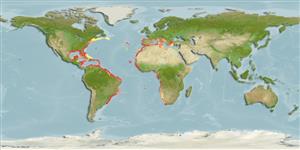>
Carangiformes (Jacks) >
Carangidae (Jacks and pompanos) > Caranginae
Etymology: Caranx: French, carangue, the name of a Caribbean fish; 1836 (Ref. 45335).
More on author: Linnaeus.
Environment: milieu / climate zone / intervalo de profundidade / distribution range
Ecologia
marinhas; estuarina pelagic-neritic; oceanódromo (Ref. 51243); intervalo de profundidade 1 - 350 m (Ref. 7097), usually 1 - 200 m (Ref. 55173). Subtropical
Atlantic Ocean, restricted to continental shelf areas. Mediterranean excluded.
Length at first maturity / Tamanho / Peso / Idade
Maturidade: Lm 66.0 range ? - ? cm
Max length : 124 cm TL macho/indeterminado; (Ref. 5217); common length : 75.0 cm TL macho/indeterminado; (Ref. 2683); peso máx. Publicado: 32.0 kg (Ref. 27584)
Espinhos dorsais (total) : 9; Raios dorsais moles (total) : 19 - 22; Espinhos anais: 3; Raios anais moles: 15 - 18. Diagnosis: Scutes on lateral line 23 (Ref. 57392) to 42 (Ref. 13442). No scales on chest (Ref. 13442), except a small mid-ventral patch in front of pelvic fins (Ref. 13442, 57392). Upper profile of head steep (Ref. 13442). Maxilla ending approximately below (Ref. 13442, 57392) or beyond (Ref. 57392) posterior edge of eye (in adult). Front of soft dorsal and anal fins elevated; olivaceous to bluish green dorsally, silvery to brassy on the sides; prominent black spot posteriorly on gill cover at level of eye, another at upper axil of pectoral fins, and often a third on lower pectoral rays; caudal yellowish (Ref. 13442).
Body shape (shape guide): fusiform / normal.
Generally in neritic waters over the continental shelf (Ref. 5217), from the coastline, where it is common on shallow flats, to offshore waters (Ref. 57392). Adults ascend rivers (Ref. 26938). Juveniles abundant in brackish estuaries with muddy bottoms, near sandy beaches and on seagrass beds (Ref. 5217), entering lagoons and lower courses of rivers (Ref. 57392). They form fast-moving schools, although larger fish may be solitary. They feed on smaller fish, shrimp, and other invertebrates (Ref. 5521). Often grunts or croaks are heard when caught. Eggs are pelagic (Ref. 4233).
Life cycle and mating behavior
Maturidade | Reprodução | Desova | Ovos | Fecundidade | Larvas
Smith-Vaniz, W.F. and K.E. Carpenter, 2007. Review of the crevalle jacks, Caranx hippos complex (Teleostei: Carangidae), with a description of a new species from West Africa. Fish. Bull. 105(2):207-233. (Ref. 58464)
Categoria na Lista Vermelha da IUCN (Ref. 130435: Version 2025-1)
Ameaça para o homem
Reports of ciguatera poisoning (Ref. 4690)
Utilização humana
Pescarias: espécies comerciais; peixe desportivo: sim
Ferramentas
Relatórios especiais
Descarregue XML
Fontes da internet
Estimates based on models
Preferred temperature (Ref.
123201): 16.5 - 27.9, mean 24.8 °C (based on 2020 cells).
Phylogenetic diversity index (Ref.
82804): PD
50 = 0.5000 [Uniqueness, from 0.5 = low to 2.0 = high].
Bayesian length-weight: a=0.01622 (0.01359 - 0.01936), b=2.96 (2.93 - 2.99), in cm total length, based on LWR estimates for this species (Ref.
93245).
Nível Trófico (Ref.
69278): 3.6 ±0.4 se; based on diet studies.
Generation time: 3.1 ( na - na) years. Estimated as median ln(3)/K based on 1
growth studies.
Resiliência (Ref.
120179): Médio, tempo mínimo de duplicação da população 1,4 - 4,4 anos (Assuming tm 3-4).
Prior r = 0.53, 95% CL = 0.35 - 0.80, Based on 5 data-limited stock assessments.
Fishing Vulnerability (Ref.
59153): Moderate vulnerability (41 of 100).
🛈
Climate Vulnerability (Ref.
125649): High vulnerability (62 of 100).
🛈
Nutrients (Ref.
124155): Calcium = 10.9 [4.1, 19.9] mg/100g; Iron = 0.33 [0.17, 0.68] mg/100g; Protein = 20.9 [18.7, 23.4] %; Omega3 = 0.218 [0.121, 0.391] g/100g; Selenium = 33.8 [14.2, 84.4] μg/100g; VitaminA = 16 [5, 56] μg/100g; Zinc = 0.357 [0.217, 0.574] mg/100g (wet weight); based on
nutrient studies.
